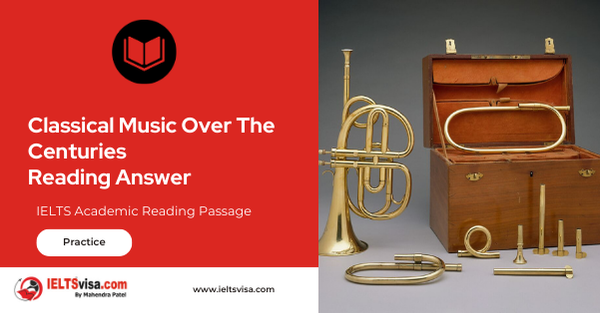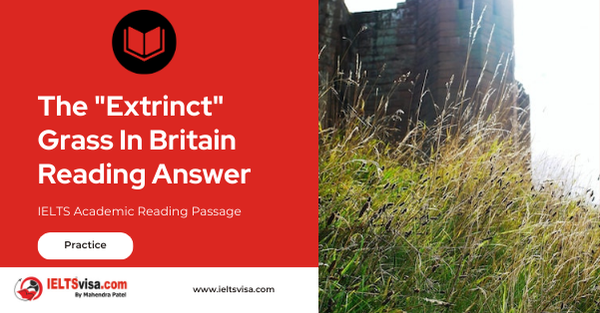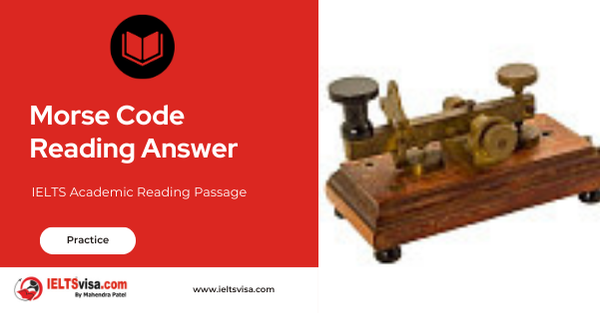Classical Music Over The Centuries Reading Answer
IELTS Academic Reading Passage
INDIAN CLASSICAL MUSIC
The origins of Indian classical music can be found from the oldest of scriptures, part of the Hindus tradition, the Vedas.
Samaveda, one of the four Vedas, describes music at length. Indian classical music has its origins as a meditation tool for attaining self realization. All different forms of these melodies (ragas) are believed to affect various “chakras” (energy centers, or “mood”) in the path of the Kundalini. However, there is little mention of these esoteric beliefs in Bharat’s Natyashastra , the first treatise laying down the fundamental principles of drama, dance and music. The Samadeva, one of the four Vedas, created out of riga-veda so that its hymns could be sung as Samagana, established its first pop.
Indian classical music has one of the most complex and complete musical systems ever developed. Like Western classical music, it divides the octave s into 12 Semitones of which the 7 basic notes are Sa Re Ga Ma Pa Dha Ni Sa, replacing Do Re Mi Fa So La Ti Do. However, it uses the just intonation tuning (unlike western classical music which uses the equal temperament tuning system).
Indian classical music is monophonic in nature and based around a single melody line which is played over a fixed drone. The performance is based melodically on particular rages and rhythmically on talas.
NATIONAL SYSTEM
Scholars of Europe in the seventeenth and eighteenth century were enormed by Indian music. With no facility to record the sound they explored for some existing system that might exist system that express sounds in the composition. There were pointers to an ancient notations system which scholars had also translated into Persian: still’ complexity of Indian classical music could not be expressed in writing. Though some western scholars did record compositions in staff notation system, Indian musicians used Pt.Bhakhande system. Though more accurate, this relies on Devanagari script rather than symbols and hence is cumbersome at times. A new notation system has been proposed which uses symbols and offers instantaneous comprehension like staff notation system. It is with standardization of a notation system that hitherto unknown compositions would see the light of day.
INSTRUMENTS
Instruments typically used in Hindustani music include sitar, sarood,tanpura, bansuri, shehnai, sarangi, and table. Instruments typically used in carnatic music include flute, gottuvadyam, veena mridangam, kanjira, ghatam and violon
Questions 1-8
Do the following statements agree with the information in reading passage?
In boxes 1-8 in your answer sheet write
YES if the statement reflects the claims of the writer
NO if the statement contradicts the writer
NOT GIVEN if it is impossible to say what the writer thinks about this
1 Out of four Vedas, music is only described in samaveds.
1. Music is believed to have an effect on human body.
2. Indian classical music system is simple and sophisticated.
3. There are 7 basic notes and 12 semitones in Indian classical music.
4. Talas in the Indian music is derived from western music
5. Indian classical music could express in writing.
6. The composition used by Indian musicians was based on Devnagri script.
7. New script used for music had no symbols.
Question 9-12
1.“Chakras” is a name given to energy centers in the path of 9…………………
2. Out of all kind of music, Indian classical music is 10………………… and having complete system.
3. Monophonic music system is based on a single 11………………….
4. The instruments flute, veena and violinare 12………………… in carnation music.

SOLUTION FOR: Classical Music Over The Centuries Reading Answer
| 1. NO | 7. YES |
| 2. YES | 8. NO |
| 3. NO | 9. Kundalin |
| 4. YES | 10. Most complex |
| 5. NOT GIVEN | 11. Melody line |
| 6. NO | 12. Typically used |
Review and Practice
- Regularly practice with IELTS reading samples and time yourself to get used to the pressure of the exam.
- Review your mistakes to understand where you went wrong and how to avoid similar errors in the future.
Our Books
Master IELTS Speaking Part 1
IELTS Writing Task 1 Book
IELTS Writing Task 2 Book
Classical Music Over The Centuries Reading Answer Explaination
Comin Soon
Practice IELTS Other Modules
IELTS Listening
The IELTS Listening test assesses how well you can understand spoken English in various contexts. It lasts about 30 minutes and is divided into four sections with a total of 40 questions. The listening tasks become increasingly difficult as the test progresses.
IELTS Academic Reading
The IELTS Academic Reading section assesses your ability to understand and interpret a variety of texts in academic settings. It is designed to evaluate a range of reading skills, including skimming for gist, reading for main ideas, reading for detail, understanding inferences, and recognizing a writer's opinions and arguments.
IELTS Speaking
The IELTS Speaking test assesses your ability to communicate in English on everyday topics. It lasts 11-14 minutes and consists of three parts: introduction, cue card, and a discussion based on the cue card topic.
IELTS General Reading
IELTS General Reading tests your ability to understand and interpret various types of texts. Here are some key areas and types of content you can expect to encounter in the reading section, along with tips for effective preparation.
IELTS Academic Writing Task 1
In IELTS Academic Writing Task 1, you are presented with a visual representation of information, such as graphs, charts, tables, or diagrams, and you are required to summarize, compare, or explain the data in your own words.
IELTS General Writing Task 1
In IELTS General Writing Task 1, you are required to write a letter based on a given situation. The letter can be formal, semi-formal, or informal, depending on the prompt. Here’s a breakdown of the key components to include in your letter
IELTS Academic Writing Task 2
In IELTS Academic Writing Task 2, you are required to write an essay in response to a question or topic. Here’s a guide to help you understand the essential elements of this task
IELTS Exam Tips
To succeed in the IELTS exam, practice regularly, familiarize yourself with the test format, improve your vocabulary, develop time management skills, and take mock tests to build confidence.
Grammer for IELTS
Grammar is the foundation of effective communication in English. Understanding tense usage, subject-verb agreement, and sentence structure enhances clarity and coherence in writing and speaking.
Vocabulary for IELTS
Vocabulary plays a crucial role in the IELTS (International English Language Testing System) exam, especially in the Speaking and Writing sections. Here’s an overview of why vocabulary is important and how it impacts your performance
RECENT IELTS SAMPLES QUESTIONS AND ANSWERS
Becoming An Expert Reading Answer
A Expertise is commitment coupled with creativity. Specifically, it is the commitment of...
STUDY CENTRE COURSES Reading Answer
SELF-STUDY TIPS AHowever difficult you find it to arrange your time, it will pay off in the...
The Extrinct Grass In Britain Reading Answer
A The British grass interrupted brome was said to be extinct, just like the Dodo. Called...
Morse Code Reading Answer
A. A new satellite-based system is being implemented to replace Morse code for sending...
Magnetic Therapy Reading Answer
AMagnetic therapy, which is a $5-billion market worldwide, is a form of alternative medicine...
Lack Of Sleep Reading Answer
Section A It is estimated that the average man or woman needs between seven-and-a-half and...













